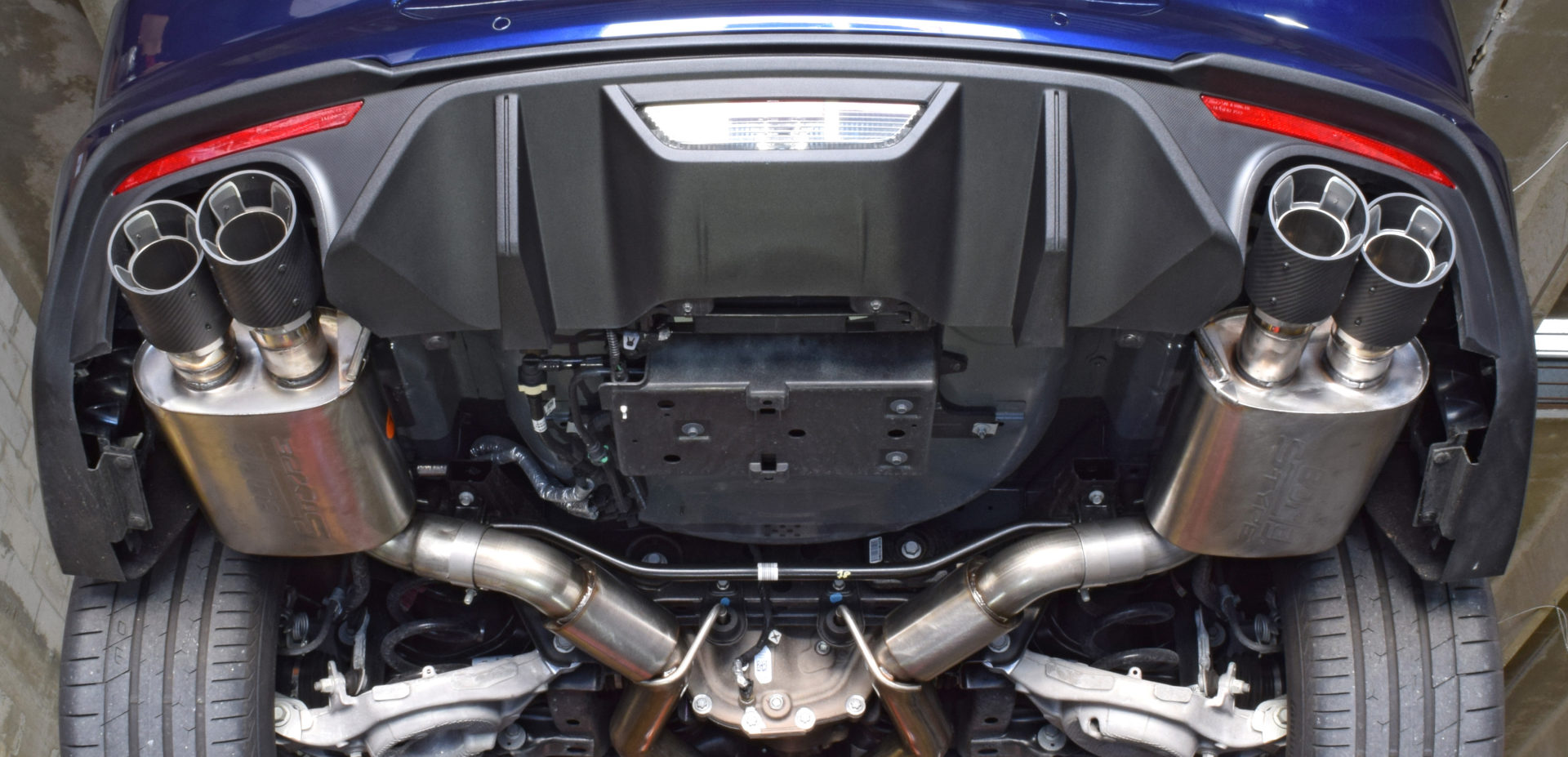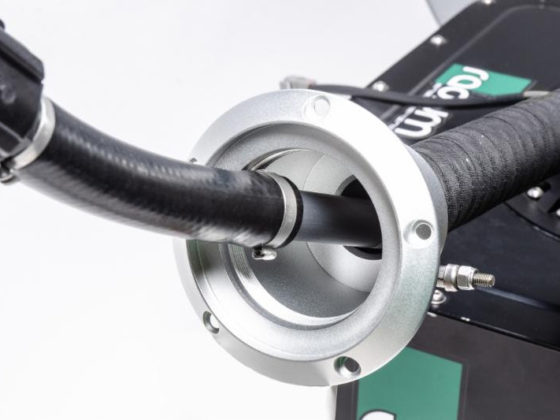For the fourth year in a row, the Mustang continues to be the “best-selling sports coupe in the entire world”. The S550 platform that debut in 2015 catapulted the brand to be a serious world-class sports car. However, in my Review of the 2015 Mustang GT, the one complaint I had was the stock sound. Borla came to the rescue with the Ford Performance Cat-Back Exhaust and GT350 Valence in our base 2016 Mustang GT.
Big changes happened to the Mustang in 2018. Not only to the styling with a facelift and much better outward visibility due to a hood that’s closer to the GT350 in shape than the previous hood, but the Gen-3 Coyote V8 now produces a staggering 460hp and 420lb-ft of torque (up from 435hp & 400lb-ft) thanks to the addition of direct injection, higher 12.0:1 compression 93mm pistons (up from 92.2mm giving a 5.035L displacement -up from 4.951L), and a revised intake manifold allows for a 500rpm higher redline -7,500rpm.

Not only does this new engine make more power, but the factory quad-exhaust was improved to make the car sound better, and the optional active exhaust (previously only available on the GT350) enables the car to have a dual personality from quiet and docile, to loud and aggressive. Our 2018 Mustang GT Performance Package does not have the active exhaust, and quite frankly, sounded so much better than the factory 2015-2017 Mustang GT exhaust that the urge to improve the sound wasn’t very strong and there was doubts about changing it at all. In retrospect, what Borla did to the 2018 Mustang GT makes their new exhaust even more worth it than it was for the 2015-17 Mustang, not because of the surprisingly substantial power gain, but for creating what I would say is one of the best sounding exhaust systems for the 5.0L V8!

The wizards at Borla did something special with the S-Type exhaust for the 2018 Mustang GT. While I was a big fan of their quietest version M-5200-M8TBV Touring Exhaust System on the 2016 GT, the new S-Type on the new Gen-3 engine sounds like no other Coyote that I’ve heard. In fact, this setup sounds more like the (arguably) better sounding 3-Valve Ford V8s with a smoother, more refined, and deep sound rather than the sharper, “poppy”, and trumpeting “rasp” of most aftermarket exhausts on Coyote-powered Mustangs. I may go out on a limb here, but this may be the best sounding exhaust that I’ve heard on an S550 Mustang GT. Seriously.
As per our usual test procedures, we had to get a baseline pull to see what our stock 2018 Mustang GT produces from the factory. We stopped by our friends at Palm Beach Dyno (known for their tuning and forced-induction work on late model Fords) to spin the rollers.


After a few pulls, the 5.0L Gen-3 Coyote consistently put down 416.82whp at 6,890rpm and 393.90lb-ft of torque at 4,630rpm; however dynoing the car in 4th gear (which is now 1:1 -vs 5th gear in 2015-17 cars) presents a slight problem with the higher 7,500rpm rev limit. The factory 155mph speed limiter kicks in around 6,900rpm.




14 comments
Really happy with the harmonics produced by my Borla Cat-back. In my youth, I once enjoyed a much louder exhaust, but now that I am much wiser, I relish a subdued but distinct aural character.
It’s interesting to note, that the exhaust flow sounds much better when paired with 4-2-1 headers, as well. There seems to be almost no downsides to a properly designed after-market exhaust system. At least, I haven’t found any.
Great stuff Billy. Fascinating to see the dyno difference between 3rd and 4th gear. And the new Coyote engine is really impressive.
Wow, the new Coyote kicks ass. I didn’t like its lack of torque before. The base engine design is excellent including the head and ports, do you know what they did to improve it? Intake manifold? That was another weakness of the engine as we made huge gains by changing that with our white project car.
The Coyote is kind of like two K24s bolted together. It’s designed for more RPM and does not have the low RPM torque of a larger stroke, larger displacement pushrod engine.
Do you have any questions beyond what was said in the second paragraph?
I wouldn’t call the 2015-17 intake manifold a “weakness”. It’s designed for packaging and more low end torque for a street driven car. The CobraJet you put on sacrifices a little in the low and mid-range for big gains at high RPM.
My Power Pack 1-3 article highlights this quite well and some people even put longer-runner F150 manifolds on for even more low-end torque for daily driving, at the cost of peak power and power up top.
I know that people are using the latest manifold on the older engine. I wonder is it is better than the Cobra Jet manifold where we saw gains across the board.
The 2018 manifold took what was learned on the GT350 manifold and has runners slightly longer & smaller than the GT350 to boost low-mid torque, while optimizing the powerband of the 2018 GT’s lower (than GT350) redline.
The 2018 manifold’s runners are shorter & larger than a stock 2015-17 manifold, so it’s actually a middle ground between them, while delivering gains across the board over the 2015-17 manifold. Due to the fact that most GTs aren’t revved to the GT350’s 8,250rpm redline, and because it has more low end torque, and (mostly) because its ALOT cheaper, the 2018 manifold is more popular than the GT350 manifold on 2015-17 cars.
In regards to the CobraJet manifold you put on: With optimized tuning for each and only changing the manifolds themselves, the stock 2015-17 manifold should have more low-mid torque than the Cobrajet due to the longer and smaller runners, vs the short, straight runners on the CJ. From 5,000rpm+ the CobraJet is similar then slightly better than the GT350 manifold at high RPM (and WAY better than the 2015-17 manifold at high RPM).
Since you’ve driven your fair share of Fords, what’s your take on the Mustang GT convertible? What does it lose dynamically?
Great article Billy! As usual, lots of details and your expertise in this stuff makes it a great read. I have only one thing to point out: Comparing the dynos of the stock 18 vs ‘16 PP3 and the 2-3whp difference, keep in mind that the 16 was dyno’d in 4th (not 1:1) which you said Ken (Palm Beach) said, in his experience, would read “10-15 whp” low. You gained 7whp from the exhaust on the 16 so the actual peak power on this dyno would be 417-422whp (~407whp stock + 10-15 from the loss using 4th). The 18 cutoff 100rpm below Fords published power peak (7K), so it is also low but it’s on that “Mesa” of power so prob not that much more to get. So it looks like the 16 PP3 either equals or just slightly exceeds the stock 2018.
BUT – that’s peak power. The massive mid range gains plus “Mesa” near the peak means I’ll bet the area under the curve is better for the stock 2018. And, as you show, make any minor mod to the 18 and you’re way above even PP3 for the 15-17. I wish Ford hadn’t killed some of the manual’s potential by using such tall gearing in tinge interest of mileage.
Thank you for the compliments. I was waiting for someone as analytical as you to make that connection and point that out. I was debating on whether to add another layer of analysis to ‘properly’ explain what you just noticed but felt 99% of the readers wouldn’t catch it and doing so would just muddy the reading with too much analysis. It just goes to show that it is extremely difficult to properly analyze and compare Dyno data, but I try to provide as much consistency and information for people to make educated decisions. Congrats on being the 1%.
Thanks for replying, and I agree with your rationale for not “muddying the waters”. Thanks again for the article and please do keep up the good work! You’re a rarity online and I know a lot of us appreciate it.
Borla also makes what appears to be a lower restriction cross-over pipe. I wonder how much more power, if any, that might free up.
https://www.borla.com/products/mustang_gt_xpipe_part__60662.html
A few months ago, I installed the borla switchfire crossover pipe on my ’15 (linked in my reply from over a year ago, above). It completely changed the tone of my gen2 coyote, and made me fall in love with the car all over again. The mufflers were the larger-boxed flowmaster FlowFX, which is a quiet straight through design. Combined, the tone has a satisfying gurgle at low revs and a screaming Euro howl towards redline.
I noticed a significant tone change dependent on whether I ran it stock, or with a steeda flash tune. The steeda tune gives it a harder “edge,” with a distinct rasp; lovely to me—de gustibus and all that.
There was a noticeable boost in low end torque, which made the rear end squirmy. Last week, I took that mid-pipe off: the drop in low end torque was immediately apparent.
I’ve saved the pipe for the ’20 Mustang GT I’m picking up next week. I might delay putting it on, because of the much improved sound of the gen3 — will swap it over once the honeymoon phase wears off.
Excellent review! Question: you say this is Borla part #140745CF, which HAS VALVES and is for GTs with active exhaust. Were you able to retro-fit a nonactive with active? Or, is the proper part # 140745CF?
In previous reply I meant to say your part # is 140742CF